


George Edward Partleton (1814-1866)
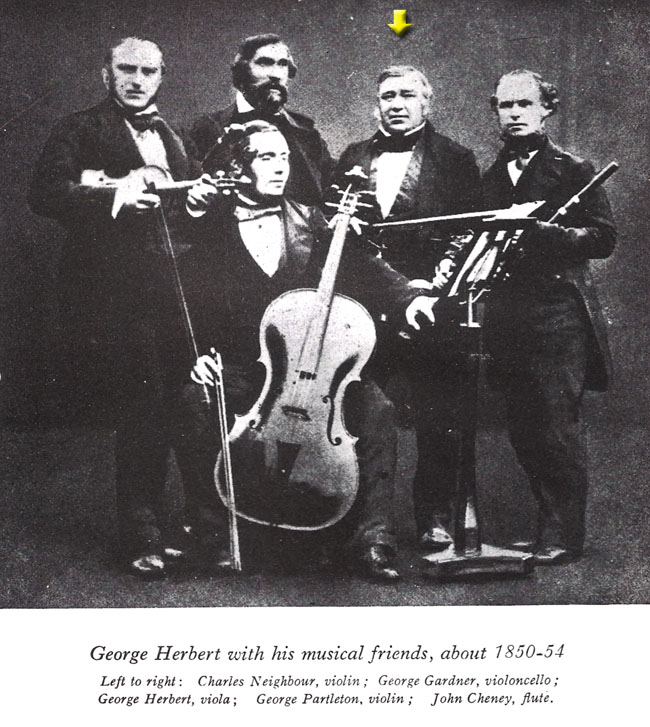
George Edward Partleton was christened on 24 October 1814 at St James Church, Westminster, along with his younger brother Henry. They were born at nearby Swallow Street off Piccadilly.
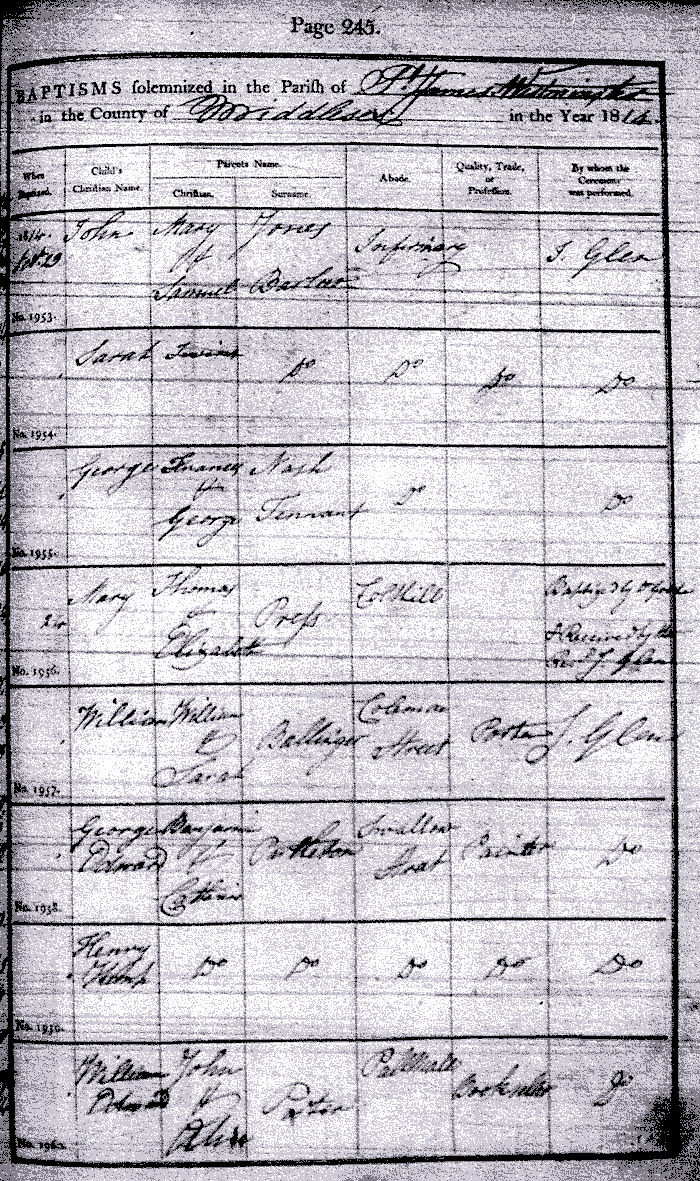
George's dad, Benjamin Partleton (1774-1833), was a house painter, but the family had theatre connections; in their young years George, his brothers Henry and James, and their sister Catherine all went on stage in London.
What we know about George Partleton's childhood is that it must have involved a serious amount of music, dancing and acting because while he is still a teenager, in the early 1830s, George joins the travelling comic acting company of Henry Jackman as an actor, dancer and musician of diverse instruments.
So we'll take a little diversion to have a look at impresario Henry Jackman. Henry was born in 1786 in the parish of St James and went on in life to form his company of travelling comic actors. He is the subject of a book Theatre Unroyal by Lou Warwick (1974 Garden City Press). In this book, George Partleton, as a member of the company, is mentioned quite a bit, and the Partleton Tree gives credit to Lou Warwick for much of the information on this page
'Old Henry Jackman's' travelling company toured a rotation of at least 26 towns in the home counties, Bedfordshire, Northamptonshire, Oxfordshire in the first half of the 19th century. Most of the company was comprised of Henry Jackman's own family; he used to cast an entire Shakespeare play almost entirely from his six daughters and three sons.
Below, amazingly, history has preserved for us (at the British Museum) a playbill of the Henry Jackman company, including the 19-year-old George Partleton, at the Wheatsheaf Inn, Woburn. The date is Monday January 9th 1832:
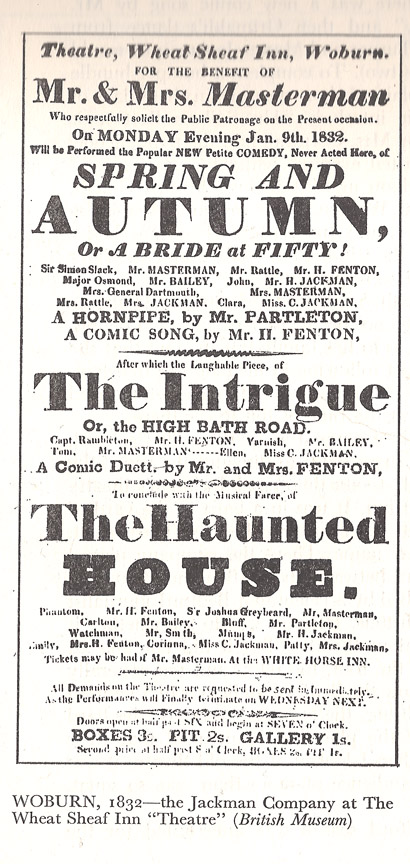
The multi-talented George plays a hornpipe and acts the part of 'Bluff' in a musical farce.
The Wheatsheaf closed 37 years later in 1869; below is a small plan showing its former location at the corn market in Woburn Town Square. The Wheatsheaf is the cluster of buildings shaded in sage green at the left of the map. 'Wheatsheaf Inn formerly Black Lion...' Can anyone decipher the word in the third building? Brewage?
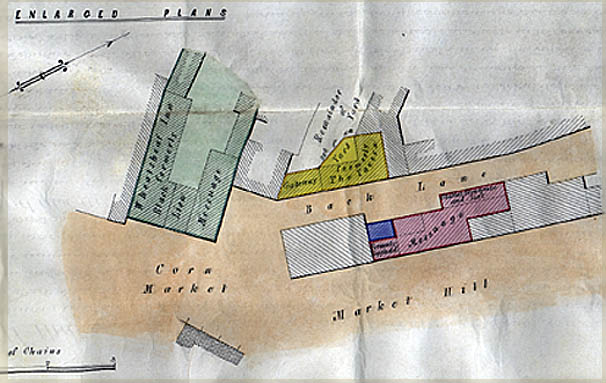
In November 2010, we were contacted by Partleton Tree correspondent Helen Warwick with the answer to that map-reading question:
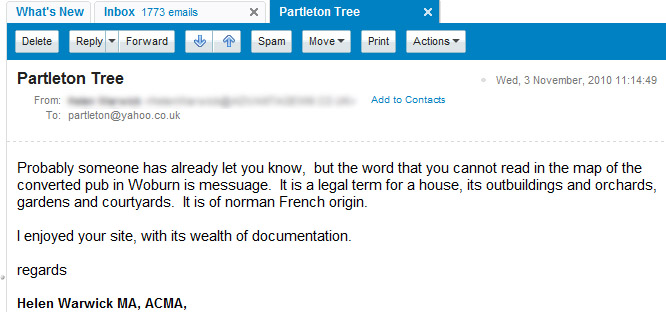
Whichever way you look at it, the back of the Wheatsheaf pub in 1832 is a very small rural venue, so let's have a look at an engraving of the 1820s showing travelling players at a rustic location, actually in a barn:

When George Partleton was playing in provincial towns, would have experienced venues just like this one at smaller places... it is while travelling with the theatre company that he becomes acquainted with his future wife, Henry Jackman's daughter Frances Jackman. George and Frances were married on Wednesday 18 June 1833 while the company were in Henley, as reported in the Oxford local paper:


We might think George's claim to be a 'Professor' is a bit grand considering he's only 19, but two years later, from the Banbury season of 1835, comes documentary testimony to the fact that the versatile George Edward Partleton was a man of many talents. This is in the shape of a leaflet he had printed to spread the news that during the season he would run a 'dancing academy':
'Mr. Partleton begs leave to announce to the Ladies and Gentleman of Banbury and its vicinity that he intends during his stay to give lessons in the above elegant accomplishment in all its branches viz. quadrilles, gallopades, waltzes etc., and most respectfully solicits the patronage of those ladies and gentlemen who may wish to profit by his instruction.'
Twenty-two years later, George was still advertising dance lessons, but has dropped the quadrilles and gallopades in favour of more modern dances:
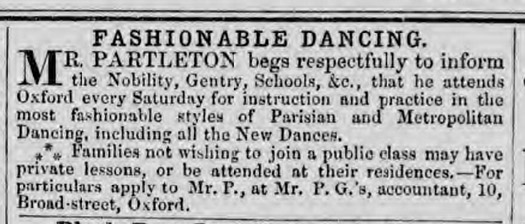 Left: Oxford Journal - Saturday 29 September 1855
Left: Oxford Journal - Saturday 29 September 1855
Back to 1835, the terms were 10 shillings a month, the lessons on Wednesdays and Fridays, at two in the afternoon for young ladies and gentlemen and at seven' in the evening for adults. He also offered to teach the violin and tune and teach the piano.
We are now coming to a period which is extremely well documented, because, amazingly, a number of the personal letters of George Partleton have survived and are held at Northampton Records Office. During his career George was in regular correspondence with his friend and business associate, Mr Thomas Lewis Gery, who was a solicitor in Daventry and a theatre fan. Through these, published in Theatre Unroyal, we get some marvellous insights into small details of the Partleton family life.
From Market Harborough, Leicestershire, on May 31, 1836, we find out some of the business side of affairs of the travelling troupe when George Partleton writes to Gery, in which George's grammar and spelling are preserved:

From this we learn that George earns his money, at least in part, from benefit performances where he would receive all the takings for a particular evening's performance. It's a gamble, which the actor could easily lose, as we see in the illustration below from The Life of an Actor, published in 1824 by Pierce Egan. A near-empty house which wouldn't even cover the company's costs for the night:
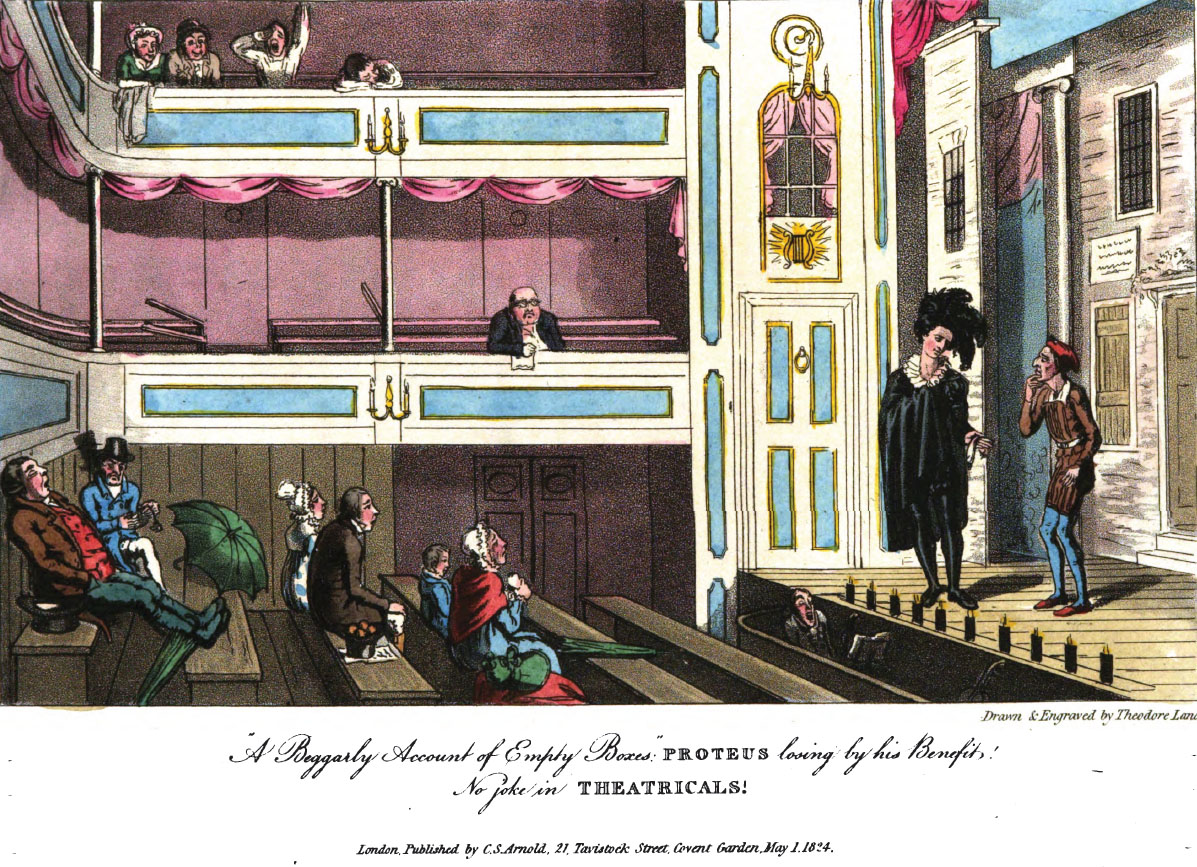
This engraving also shows us a super example of what we might expect to see in the interior of a small provincial theatre such as George would have played.
But on other occasions, there would have been full houses, as is illustrated in the same book; a boisterous and mischievous crowd queuing and jostling to get into a performance with a guest actor from London. A lady has fainted in the crush:
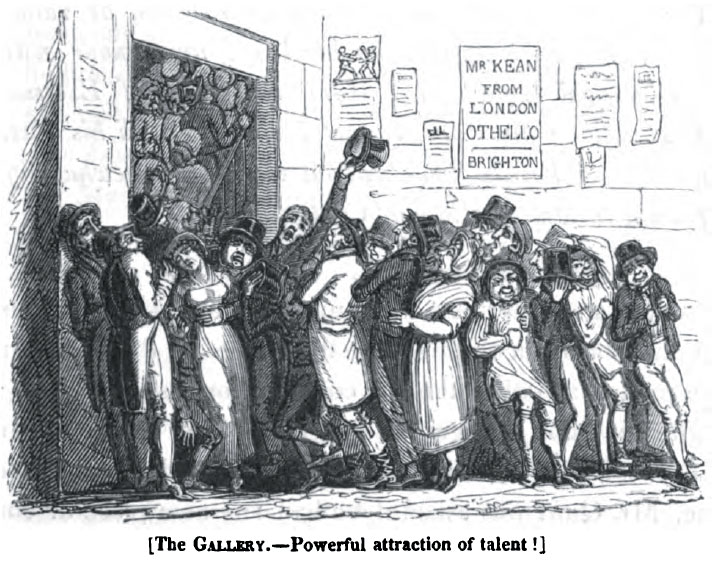
In George's letter of 31 May 1836, there's an apologetic postscript where we get a glimpse of this lifestyle of moving from town to town and staying in pubs:

We can track the movements of George and Frances over the next few years, through the birth (and deaths) of their children; George (1834 Chipping Norton), Catherine (1835 Newport Pagnell), Edward Charles (born 1837 Bedford, died 1838 Bromsgrove), Helen (born April 1839 Uxbridge, died July 1839 Northampton), Edward Frederick (born 1840 Bedford), Frances Helen (born 1841 Northampton).
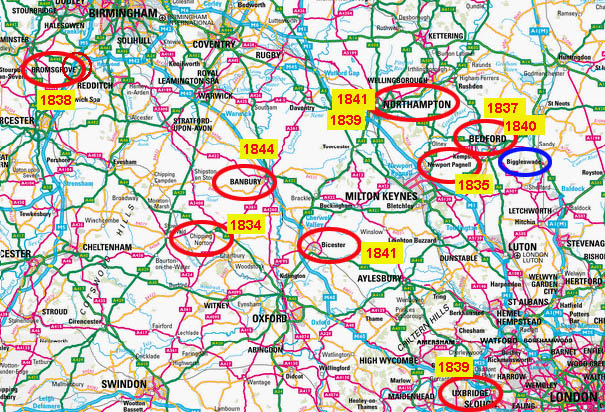
As we can see, as 'strolling players', the family moved about a lot. Really, a lot. We only see snapshots where the children are born, but there must have been many, many more moves and the life of this family must have been quite lively, not to mention exhausting, during these years.
Pierce Egan again furnishes us, in the picture below, with another illustration from his 1824 book which helps us to visualise what could equally be the Jackman company arriving at a small-town venue, complete with theatre-wagon loaded with scenery, instruments, props, and actresses stacked on top:
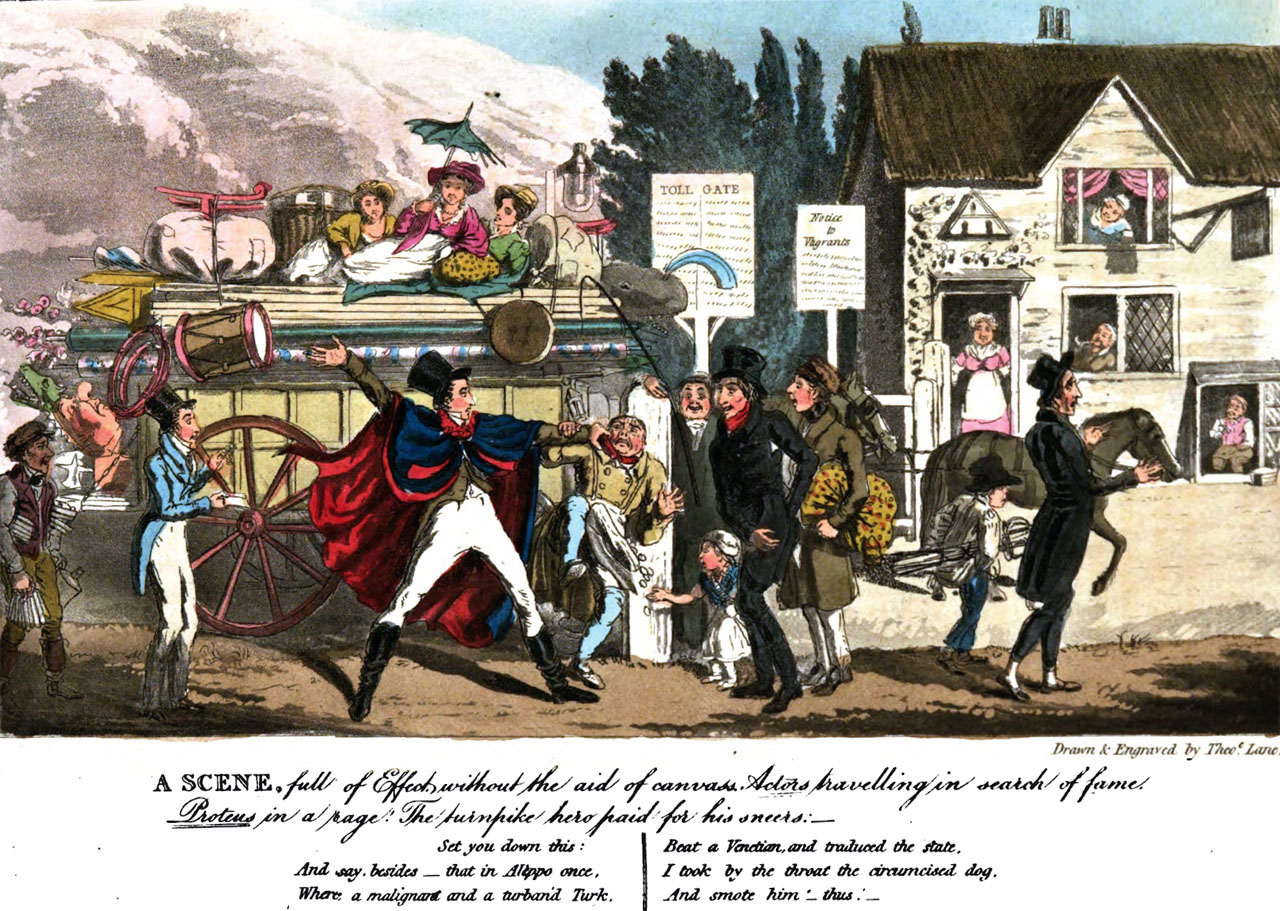
The valiant actor has grabbed the turnpike-keeper by his collar for daring to ask for the toll. Tolls were how road maintenance was funded at the time. I guess tollbooth keepers in 1824 were about as popular as traffic wardens today. Necessary but unpopular. The residents of the inn, at the right, where the travelling company will probably stay, look on approvingly, waiting for their paying guests.
Back to our George. We also learn from his correspondence at this time that he augmented his income also by selling music and violin strings.
But we have still more details to fill in the gaps... below is an actual playbill of the company appearing at Bedford. The date is Monday 31 July 1837.
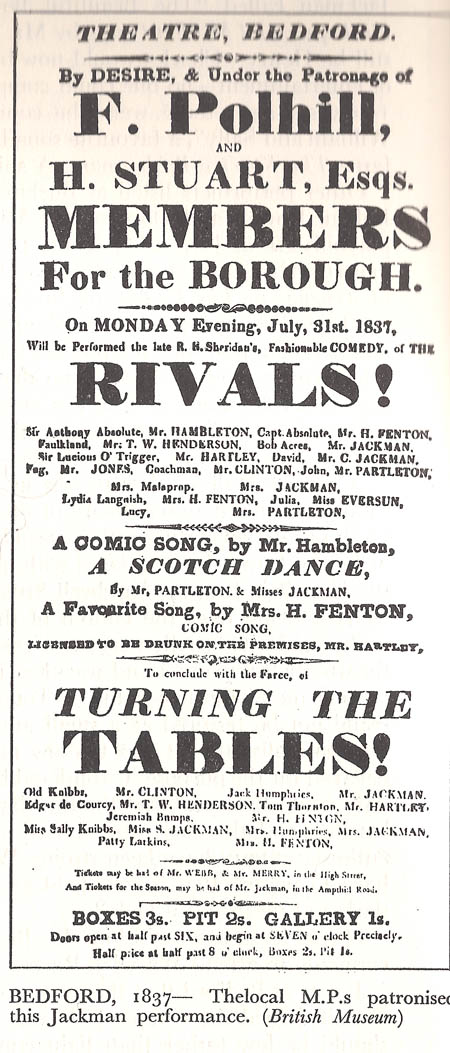
Above we see George and his wife Frances, now married, both appearing together in the famous Richard Sheridan comedy The Rivals. George also performs a 'Scotch Dance' with his sisters-in-law. The show was performed in front of the local MP's. In the play, George has the role of 'John', and Frances performs the role of 'Lucy'.
This provides us with an insight into the lifestyle of the travelling performer... because on that night of 31 July, Frances is 8 months pregnant, so although she takes a part in the play, presumably she is not one of the 'Misses Jackman' leaping around doing a Scotch Dance. Just five weeks later, on the 6th September 1837, the couple are still in Bedford, and she gives birth to her second son, Edward Charles Partleton. Unfortunately, little Edward is to die within a year. Imagine poor Henry and Frances' situation: after this disaster they have to continue to perform in comedies and to make people laugh.
And the tragedy is set to continue. In May 1839 in Uxbridge, Frances gives birth to her second daughter, Helen. Within three months, the family are in Northampton where the researches of Terry Partleton have thrown up a fascinating and tragic newspaper story from the Northampton Mercury of September 1839:

Laudanum is an opium derivative and was in very widespread use as medicine in Victorian times for both adults and children. It was dangerous indeed, and extremely easy to fatally overdose, as we witness above. The death of little Helen Partleton was also noted in the book Theatre Unroyal, where the death certificate is identified as recording 'Death through medicine incautiously administered'.
In late 1840, Frances gives birth to another baby boy, whom they again name as Edward, this time Edward Frederick.
A short while later In a letter he wrote from the Kings Arms, Leighton Buzzard on February 28, 1841, George might have an eye to posterity.

Then we learn a little about his son George Partleton Jr, who is just six years old but already immersed in the acting business, and indeed is acting in London:

Clearly money is a little tight from time to time.
More family news given in a second letter, from Northampton at the end of March 1841...

And if you are hoping that George and Frances' woes are over, unfortunately they are not. For little baby Edward was indeed very ill, and died within a few weeks of the letter. But at the same time of Edward's death, Frances is already again pregnant with her third daughter, Frances Helen.
So we move on two more months to the night of 6 June 1841, the night of the first proper census to be held in England. Here we find George Edward Partleton with his family lodging at Market Place, Bicester. This census information came an early stage of investigation, before all the previous evidence had been unearthed, and the discovery of George gives the family tree researcher a very nice surprise. Among the myriad humdrum occupations listed; barber, milliner, baker, we find George's to be rather different; Comedian.
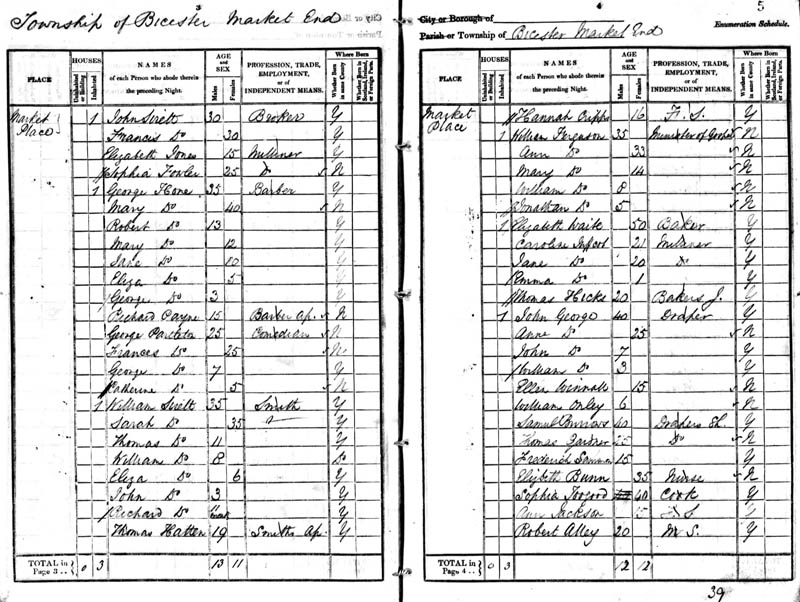
So, to recap, the family at this time consists of George, Frances and their two children, George and Catherine. But Frances is now four months pregnant with her daughter Frances Helen who was to stay with her for a further 66 years till the end of her life.
So what did Bicester Market Place look like? We have a late Victorian picture of the Market Place, also known as Market End, really an attractive market square. In fact we have a whole set of them and they are so nice that we should take the opportunity to see the Market Place as George and Frances did... step into their shoes on that sunny Victorian summer's day:
If I have calculated from the census correctly, the family are staying two houses along from the Cross Keys Inn, which can be seen in the above photo. Step into Their Shoes!
Here's a little map of Bicester:
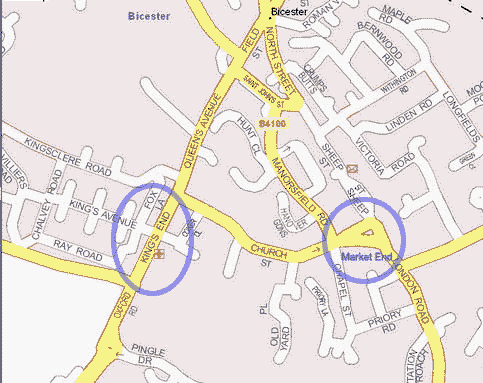
Examination of the 1841 census shows that the whole Jackman ensemble have taken lodgings in the town centre. Below we see old Henry with some more of his family, all comedians, at Kings End which can be seen just up the road from Market End on the above map:
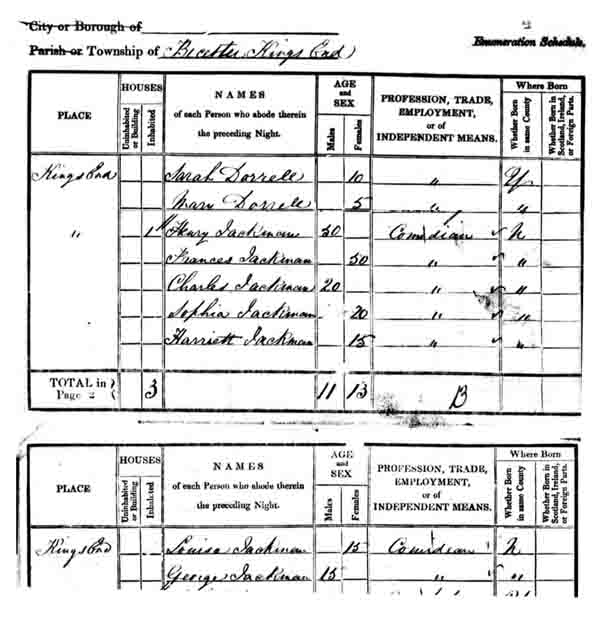
We move on a year to 26 March 1842, where George writes a letter about the company's recent season at Uxbridge and exposes a raw nerve about the press:

In George's opinion the company was 'very good' at this time.
It is frustrating that we never get to see faces amongst all this history, but It is from Uxbridge at earlier times that we can furnish a face, a person whom George Partleton would certainly have met and very likely worked with, because he is a close friend of old Henry Jackman, and he had been a member of the Jackman Company in its earlier days. This is the celebrated Victorian comedian Henry Compton, grandfather of actress Fay Compton. Here is a picture of Mr Compton at a time when George Partleton would have known him:
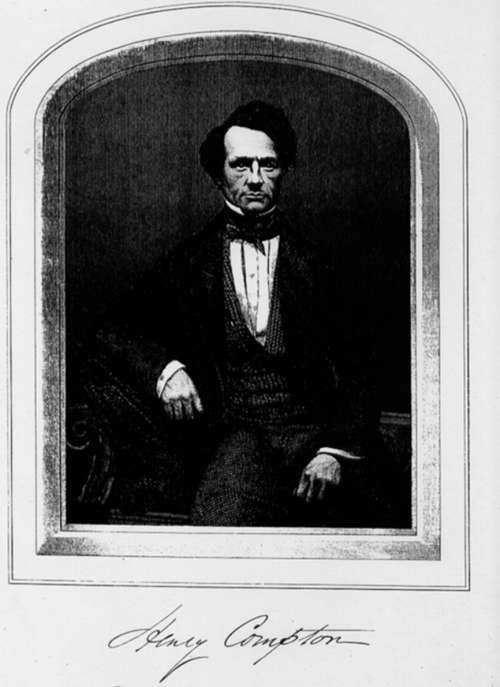
Henry Jackman features prominently in Henry Compton's memoirs.
Moving on to the 1842 season in Leamington, as described in Theatre Unroyal, George Partleton wrote two letters to Gery, on May 12 and June 8, both mainly concerned with George's sideline of selling music and books, the first:

The second Leamington letter, written towards the end of the season, George reveals that a few days earlier the company did not know where they were going next...

This uncertainty must have added a certain zest to the stroll in life, a break in the routine of familiar theatres and lodgings.
After arriving at Newport Pagnell, George Partleton wrote again:

This was not the first time George Partleton had pleaded poverty.

A very interesting insight into the personality of old Henry Jackman was revealed in August 1843 in a letter written to Gery by a long-standing member of the travelling company, Henry Hartley, the husband of another of Henry Jackman's daughters. It seems that, as is common with self-made men, Henry was not the easiest person to work for:
'I have been bothered of late pretty much - must leave particulars till I see you - suffice for the present - manager DISPLEASETH me' [the manager was, of course, his father-in-law, so it it quite possible that Hartley could discuss these particular problems better with his friend than with his wife] 'felt annoyed, truly to confess to you ill treated - gave notice to cut - had an offer from Bennett to go to Worcester this week - accepted it - manager confessed to temper not being as ought to hoped I should not leave him and finally asked me to write and cancel the arrangement with Bennett - after this - I could not do otherwise - have done so although the other does not like it and am now going to continue as before unless anything good should turn up - in London or provinces - for two years at expiration of which time I shall in all probability close theatrical career.'
At some time before 1844, George and Frances give up the travelling life settle down in Banbury, in a district called Neithrop, as music teachers. But they also continue with the acting as can be seen in the following playbill for January 14 1846. Both George and Frances appear with the Jackman Company at the theatre in Banbury:
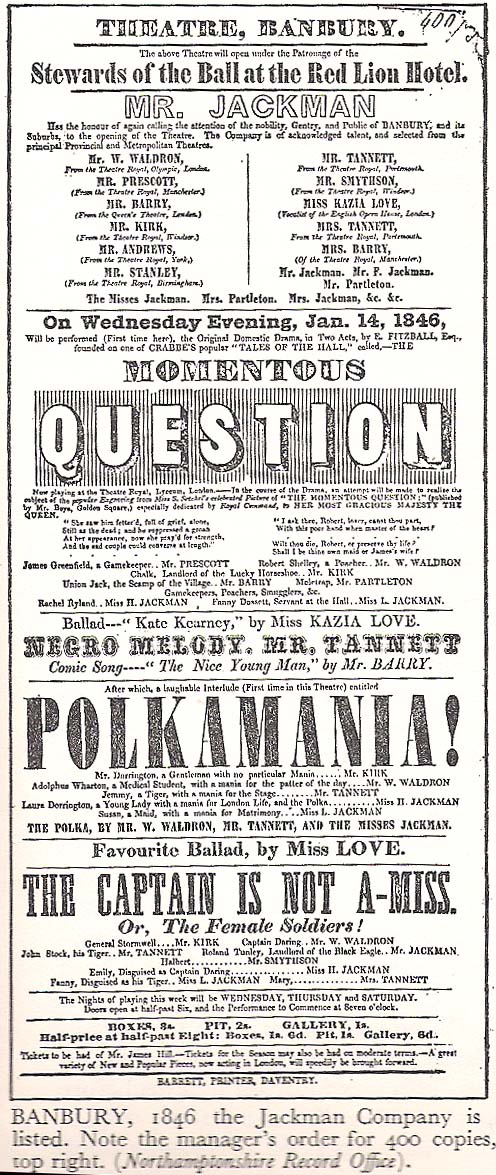
During this time George Jr remains with his granddad Henry Jackman and continues to perform as a strolling actor for the rest of his life, which as we shall see later, was not a long one.
Meantime, in 1848, we find George Partleton Sr, now aged 35, at the Daventry Theatre, as recorded (and mis-spelled, no doubt much to his annoyance) in the Theatrical Times:
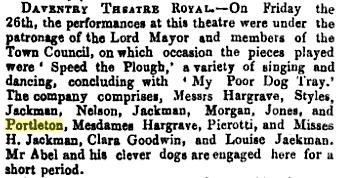
We learn that the entourage concluded with My Poor Dog Tray, a melancholy song on the subject of a dead dog.
Though my wallet was scant I remembered his case
Nor refused my last crust to his pitiful face
Though he died at my feet on a cold winter's day
And I played a lament for my poor dog Tray
Also mentioned is the Irish reel Speed the Plough, written by John Moorehead in 1798, and, since this tune is still played today, and I found a version on YouTube, we have a nice opportunity to step into George's shoes and hear the reel exactly as he would have played it:
Moving on three years, in the 1851 census we find George and Frances living with their four daughters at Back Lane, Neithrop, Banbury. George and Frances' occupations are both 'Teacher of Music'.

Here's the location of Back Lane, circled in red in Banbury town centre:
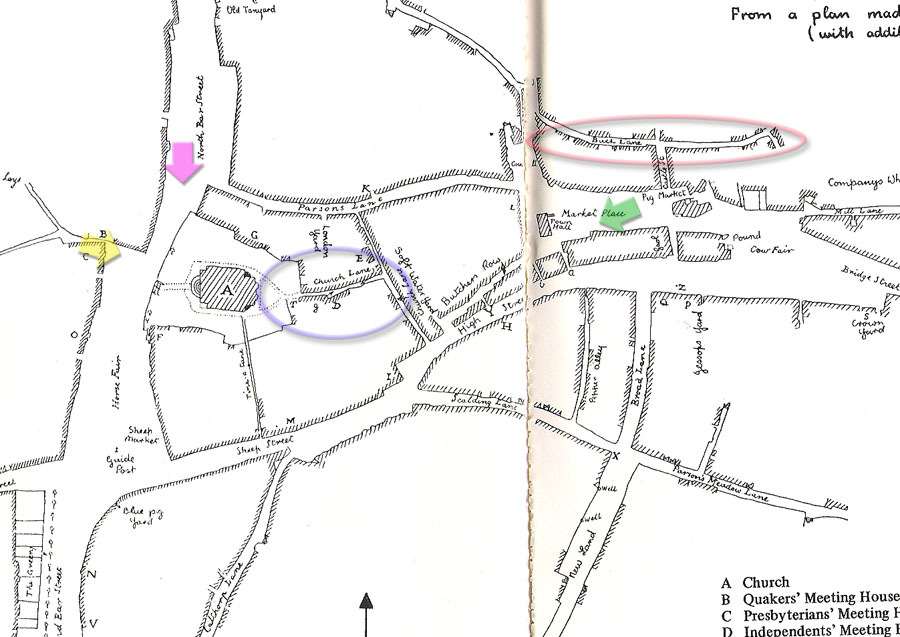
Finally in the 1861 census we find that George again declares himself to be 'Professor of Music', and why not, given his versatility and experience. Frances remains a humble Teacher of music.
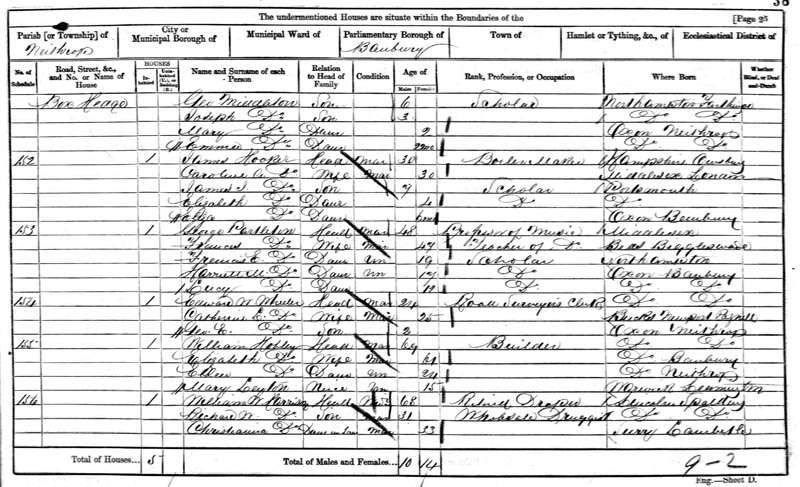
It's been possible to track George through all these censuses thanks to the amazing records held by Ancestry.co.uk. If you're inspired by this website to seek out your own British ancestors as I have done, click here.
The family is now living at Box Hedge, a street in Neithrop (a district of Banbury), just discernible, circled in blue in the map below. We can see the town centre of Banbury - Horse Fair, containing the famous Banbury Cross which we all know from the nursery rhyme - bottom right in the map.
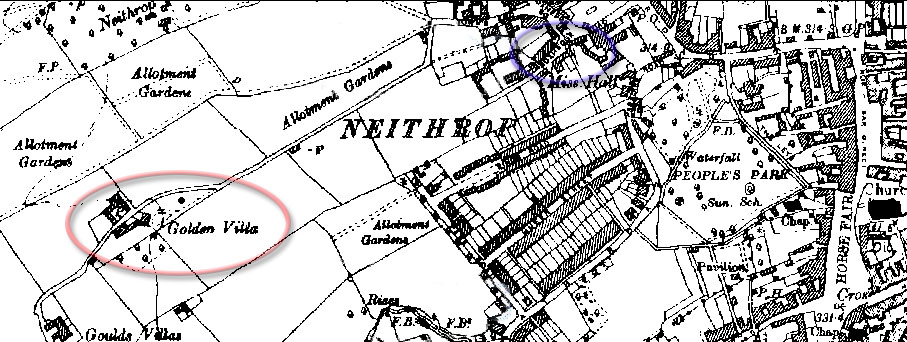
George's status as a performer resulted in something absolutely unique to us... his photograph!

This photograph was taken by George Partleton's friend George Herbert who was an early amateur practitioner of the newly-discovered art of photography. George Partleton is indicated by the yellow arrow. In 1900, George Herbert, then aged 86, wrote a book of memoirs called Shoemaker's Window, and it is in this book that we find the photograph of the musical group. Indeed, we know exactly where this picture was taken, as described by George Herbert himself:
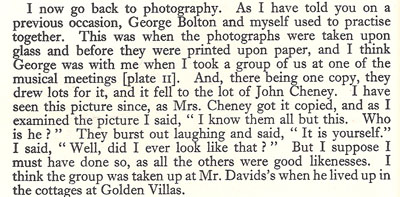
So the picture was taken at Golden Villas which we see circled in red in the map:

George's father-in-law Henry Jackman was the manager of the the theatre in Banbury which was located at 11 Church Lane and there can be no doubt that George, his wife Frances, and all of their children must have performed in this small theatre many times. We learn more about this from Shoemaker's Window:
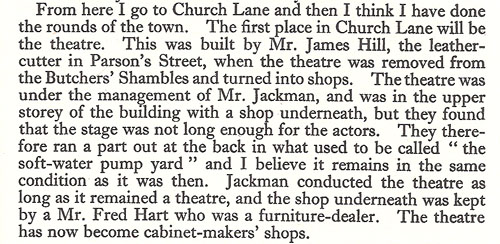
Here's the location of Church Lane, circled in blue in Banbury town centre:

Below we see an advert which George placed in his local paper, Jackson's Oxford Journal on 29 September 1855:
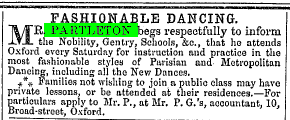
George Partleton and his family were much involved in public musical events and performances in Banbury during his lifetime, and George became the leader of the Banbury Philharmonic Society.
In 1865 George became gravely ill with cancer, and on 5 April 1866 a 'Grand Vocal and Instrumental Concert given by the Banbury Philharmonic Society for the benefit of their leader Mr Partleton' was held, with Mrs Parslow, Mr J. H. Collins and Mr H. Wootton (vocal), conducted by Mr J. S. Wells. The original programme for the concert has survived and is held at Westgate Central Library Oxford.
The concert was performed at Banbury Town Hall, seen below:

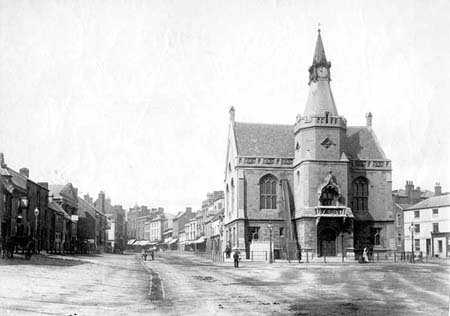
These photographs were taken from the viewpoint of the green arrow in the map below:

George died six weeks after this benefit concert, on 21 May 1866, aged 53. His death certificate, obtained by Terry Partleton, reveals that he died of 'fungus hematodes', Victorian terminology for cancer.


But this is not the end of the story... to continue with the tale of George's children and his wife Frances, who outlived him by 41 years, click here.
If you enjoyed reading this page, you are invited to 'Like' us on Facebook. Or click on the Twitter button and follow us, and we'll let you know whenever a new page is added to the Partleton Tree:
Do YOU know any more to add to this web page?... why not send us an email to partleton@yahoo.co.uk
Click here to return to the Partleton Tree 'Showbiz Partletons' Theatre Page
